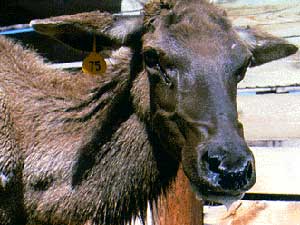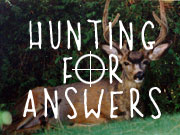CWD found in wild elk in South Dakota
November 19, 2002
 |
| An elk infected with chronic wasting disease (Photo courtesy of Wisconsin DNR) |
Sioux Falls, S.D. — South Dakota began testing for chronic wasting disease in 1997. A captive elk tested positive and the entire herd was killed. Last year a wild deer tested positive. Ron Fowler is a spokesman for the State Game, Fish and Parks Department.
"Prior to this year, we've tested probably 1,700 animals. And only the one turned out to be positive," Fowler says.
This year, the Game, Fish and Parks Department is testing 1,500 animals from a 10-county area. It's what they're calling an upgraded surveillance. Hunters who kill deer or elk in that area can have the animals tested for free. Fowler says this helps the state track the disease.
The elk that tested positive for CWD was from Wind Cave National Park. The state has no authority to manage the elk population within the park boundaries. Park officials did not return phone calls for this story.
Ron Fowler from the state Game, Fish and Parks Department says there are about 600 elk within the park. He says there is no hunting in park boundaries, but elk roam into hunting areas. Fowler says it's important to keep the elk herd small, because CWD is transmissible from animal to animal. "We'll do what we can on the outside of the park in terms of maintaining a fairly high harvest of animals for surveillance, and for keeping the population under control so it doesn't become too high," Fowler says.
Fowler says they keep finding CWD - because they're looking for it.
State veterinarian Sam Holland says it's important for wildlife officials to not overreact when it comes to CWD.
"People respond in haphazard ways -- rather than in making their decisions on good science, good judgement and common sense. I would hope we haven't pushed the panic button, since we've been faced with the disease for a number of years -- knowing it exists, doing concerted surveillance, looking for the disease," says Holland.
The Wind Cave National Park received a $280,000 grant to conduct a multi-year study. They'll look at deer movement patterns, and will do live tests for chronic wasting disease. The study will begin in February.
Elk hunting is very popular in the Black Hills. Officials limit the number of permits as a way of growing the elk herd. This year there were 12,000 requests for 1,100 licenses. The state also requires those who get an elk tag to wait 10 years before applying for another one.
Gary Wolfe is an elk hunter from Montana. He supervises a chronic wasting disease informational Web site. He hunts for elk in Colorado's endemic area. Wolfe says he doesn't want to make light of CWD, but to him, it's not a serious risk.
"I would rank my concerns about chronic wasting disease as a human health risk to me -- while I'm hunting -- probably somewhere below being struck by lightning or having a tree fall on me while I'm hunting," he says.
Wolfe says he's watching how each state reacts when it finds CWD. Wolfe says there's a wide range of reaction --from eliminating entire herds like in Wisconsin, to taking a more wait-and-see approach like South Dakota.
"I'm sure there's a best way. The problem is, we don't know what the best way is right now," he says.
Wolfe agrees with waiting for science to dictate how to manage chronic wasting disease.
The Food and Drug Administration issued an order this week telling rendering companies to avoid deer and elk carcasses from endemic areas. The rendering companies that pick up carcasses from local meat lockers say they won't sort the deer, so they won't pick up any.
State officials are telling hunters and meat processors to send carcasses to the landfills. In the state's largest community of Sioux Falls, the landfill is preparing for 4,000 carcasses.
|
News Headlines
|
Related Subjects
|

